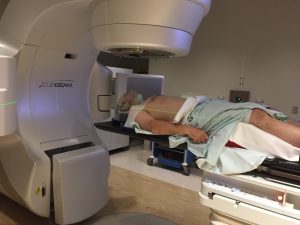
Radiotherapy, also known as radiation therapy, is a medical treatment that uses high-energy radiation, such as X-rays, gamma rays, or electrons, to kill cancer cells or shrink tumors. The radiation damages the DNA in cancer cells, preventing them from dividing and growing, and eventually causing them to die. Radiotherapy is often used in combination with other cancer treatments, such as chemotherapy or surgery, to improve the overall effectiveness of the treatment. It can be used to treat many types of cancer, including breast cancer, lung cancer, prostate cancer, and many others. The global radiotherapy market size was valued at $6.5 billion in 2021, and is projected to reach $11.9 billion by 2031, growing at a CAGR of 6.3% from 2022 to 2031.
Radiotherapy can be delivered externally or internally. External radiation therapy involves delivering radiation to the tumor from a machine outside the body, while internal radiation therapy, also known as brachytherapy, involves placing radioactive sources inside the body, in or near the tumor. The goal of radiotherapy is to deliver a high dose of radiation to the cancer cells while minimizing the dose to the surrounding healthy tissue. To achieve this, the radiation is carefully planned and delivered by a team of radiation oncologists, medical physicists, and radiation therapists.
Radiotherapy can have side effects, such as skin irritation, fatigue, and nausea, but these can usually be managed with medications and supportive care. The benefits of radiotherapy in treating cancer often outweigh the potential risks and side effects, and it can be an important part of a comprehensive cancer treatment plan.
Radiotherapy has been an important and effective treatment for cancer for many years, and it is likely to continue to be an important part of cancer treatment in the future. However, it is not the only treatment option, and the future of cancer treatment will likely involve a combination of different approaches.
Advancements in technology, such as the development of more precise radiation delivery systems, such as intensity-modulated radiation therapy (IMRT) and stereotactic body radiation therapy (SBRT), have made radiotherapy more effective and precise, and reduced its side effects.
Additionally, researchers are exploring new approaches to combine radiotherapy with other treatments, such as immunotherapy, to improve the overall effectiveness of cancer treatment.
However, it’s important to note that cancer is a complex and diverse disease, and the best treatment approach for a particular patient depends on many factors, including the type of cancer, the stage of the disease, and the patient’s overall health. The future of cancer treatment will likely involve a personalized approach that takes into account each patient’s unique needs and circumstances.
Download Free Sample PDF:
https://www.alliedmarketresearch.com/request-sample/2367
What are the 3 types of radiation therapy?
There are three main types of radiation therapy used in the treatment of cancer:
- External beam radiation therapy: This is the most common type of radiation therapy. It involves delivering radiation to the tumor from a machine outside the body. The machine aims a beam of high-energy X-rays, gamma rays, or electrons at the tumor, and the radiation kills cancer cells or slows their growth. External beam radiation therapy is typically delivered in daily treatment sessions over several weeks.
- Internal radiation therapy: This type of radiation therapy is also known as brachytherapy. It involves placing radioactive sources, such as seeds or wires, inside the body, in or near the tumor. The radiation is delivered over a period of time, and the sources are removed once the treatment is complete.
- Systemic radiation therapy: This type of radiation therapy involves delivering radioactive substances, such as radioactive iodine, directly into the bloodstream. The radioactive substance travels throughout the body and is taken up by cancer cells, where it delivers a dose of radiation to kill the cells.
The choice of radiation therapy depends on many factors, including the type of cancer, the size and location of the tumor, and the patient’s overall health. Often, a combination of different types of radiation therapy may be used in combination with other treatments, such as surgery or chemotherapy, to maximize the effectiveness of the treatment.
Radiotherapy is a common and important treatment for cancer, and it is in high demand. According to the American Society for Radiation Oncology, approximately 50% of all cancer patients receive some form of radiation therapy as part of their treatment.
As the population ages and cancer rates continue to increase, the demand for radiation therapy is likely to grow. In addition, advances in technology have made radiotherapy more effective and precise, making it an increasingly attractive option for cancer treatment.
However, access to radiation therapy may vary depending on geographic location, healthcare system, and other factors. In some regions, there may be a shortage of radiation oncologists, or patients may face long wait times for treatment. In addition, the cost of radiation therapy can be a barrier to access for some patients, particularly those without insurance or with limited financial resources.
Overall, the demand for radiotherapy is likely to remain high as it continues to be an important and effective treatment for cancer. Efforts to improve access to and affordability of radiation therapy are important to ensure that patients can receive the treatment they need.
Contact:
David Correa
USA/Canada (Toll Free): +1-800-792-5285, +1-503-894-6022

